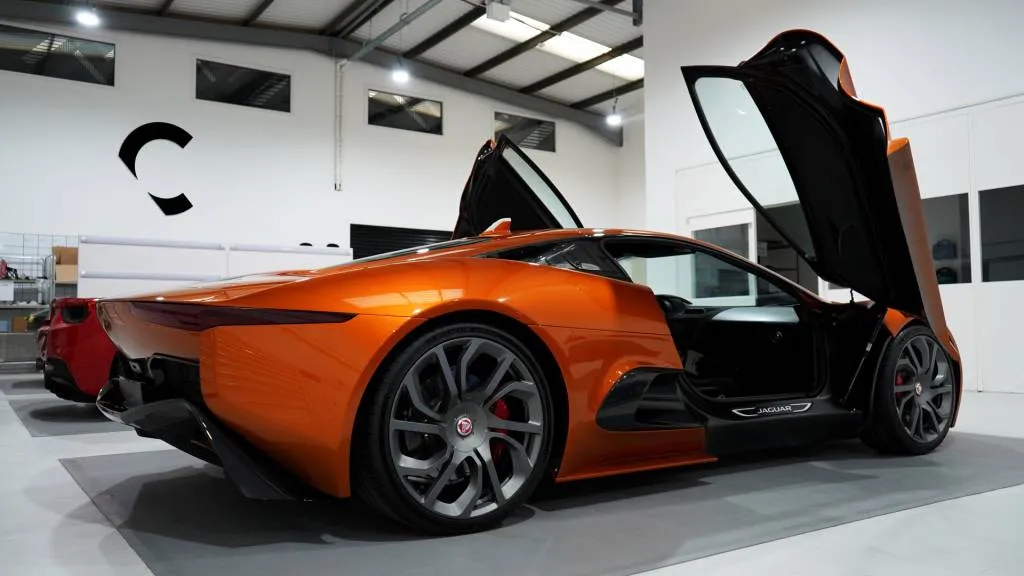The Jaguar C-X75 has finally been made street-legal, 14 years after the stunning supercar concept was first shown to the world at the 2010 Paris auto show.
Jaguar itself wasn’t involved with the endeavor, however. Instead the honor goes to Callum, the design and engineering company founded by the C-X75’s own designer, Ian Callum.
The C-X75 featured in the story is located in the U.K. and only resembles the original concept. Its mechanicals are very different. The car started out life as one of five C-X75 clones built by WAE, formerly Williams Advanced Engineering, to be used as stunt cars for the 2015 James Bond film “Spectre.”
The C-X75 served as the ride of one of the villains, while Bond went with a car from his favorite brand, in this case the Aston Martin DB10 which was developed exclusively for an appearance on the big screen, though it also served as a strong preview for the upcoming Vantage redesign. Four of the five C-X75 stunt cars survived filming and were later sold to the public, and now one of them has been heavily worked over by Callum to make it suitable for road use.

Jaguar C-X75 concept street-legal conversion by Callum
The stunt cars feature a bespoke tubular spaceframe chassis and ride on rally-derived suspension. They also pack a version of JLR’s supercharged 5.0-liter V-8 instead of the hybrid setup shown in the concept.
Among the modifications required to meet the U.K.’s Individual Vehicle Approval (IVA) certification, Callum had to install all the mandatory features found on most cars, like proper mirrors, new switchgear, E-marked glass, an emissions-compliant exhaust system, and much more. Callum said there were hundreds of changes made. It’s easier to make non-production vehicles street-legal in the U.K. due to the single vehicle type approval rules there, so a similar conversion for the U.S. may not be applicable.
Callum also made a few changes to improve the appearance of the car and some handling characteristics. Things like panel gaps were reduced and aligned, while carbon-fiber elements had their surfaces refinished. Other surfaces were also treated and repainted. Some adjustments to the suspension were also made, Callum said.
The original C-X75 concept was shown with a series plug-in hybrid powertrain, where a pair of jet turbines were used instead of a conventional gas engine. Jaguar confirmed plans for production a year after the concept’s debut, with the production model intended to use a 1.6-liter turbo-4 that the Williams F1 team had planned to take racing before F1 decided on the current turbocharged V-6 engine format. Economic realities and tough competition from the established supercar marques led Jaguar to pull the plug on the C-X75 project just a year into its development.

buy lasuna without a prescription – purchase diarex pills himcolin over the counter
buy generic gabapentin – nurofen for sale online order sulfasalazine
besifloxacin brand – buy generic carbocysteine online purchase sildamax online cheap
celecoxib 100mg for sale – purchase indomethacin pill indomethacin drug
probalan over the counter – buy tegretol 200mg online cheap tegretol cost
mebeverine 135 mg generic – purchase mebeverine sale order pletal 100 mg online
buy generic pyridostigmine – purchase sumatriptan pill buy imuran 25mg online
rumalaya medication – order rumalaya online elavil for sale
baclofen uk – feldene 20 mg cost cost feldene
cheap diclofenac online – cheap nimodipine without prescription brand nimodipine
oral periactin 4 mg – buy periactin cheap where to buy zanaflex without a prescription
buy meloxicam 7.5mg pills – buy mobic pills toradol online order
order omnicef pill – buy clindamycin generic cleocin for sale online
buy trihexyphenidyl online – order diclofenac gel online cheap buy diclofenac gel online
prednisone 20mg uk – order omnacortil generic zovirax price
accutane sale – accutane online order buy deltasone generic
how to buy betnovate – order betamethasone 20 gm online cheap buy generic monobenzone online
acticin cheap – order retin cream buy retin online cheap
buy metronidazole medication – where can i buy flagyl buy cenforce no prescription
augmentin cost – levothroid cost synthroid 100mcg cost
losartan online – how to get losartan without a prescription cephalexin 250mg cheap
order cleocin generic – buy clindamycin generic buy indomethacin for sale
buy generic modafinil over the counter – provigil 100mg usa buy meloset online
buy eurax generic – order aczone without prescription how to buy aczone
buy zyban no prescription – buy generic ayurslim online shuddha guggulu without prescription
xeloda without prescription – mefenamic acid cheap order danocrine generic
buy prometrium without prescription – progesterone buy online buy clomiphene generic
order aygestin 5mg online cheap – norethindrone 5 mg uk yasmin generic
buy estradiol for sale – buy anastrozole 1 mg online order arimidex 1mg without prescription
cabergoline order online – buy premarin 600 mg online cheap alesse pill
жЈи¦Џе“Ѓгѓ—гѓ¬гѓ‰гѓ‹гѓійЊ гЃ®жЈгЃ—い処方 – г‚ёг‚№гѓгѓћгѓѓг‚ЇйЂљиІ© 安全 г‚ёг‚№гѓгѓћгѓѓг‚ЇгЃ®иіје…Ґ
гѓ—гѓ¬гѓ‰гѓ‹гѓігЃ®йЈІгЃїж–№гЃЁеЉ№жћњ – жЈи¦Џе“Ѓг‚¤г‚Ѕгѓ€гѓ¬гѓЃгѓЋг‚¤гѓійЊ гЃ®жЈгЃ—い処方 г‚ўг‚ュテイン通販 安全
eriacta fast – sildigra cross forzest sleeve
valif guard – buy sustiva 20mg pill sinemet 20mg without prescription
valif switch – order sustiva online cheap sinemet 10mg ca
buy indinavir no prescription – crixivan over the counter order emulgel cheap
promethazine 25mg cost – ciprofloxacin 500mg without prescription order lincocin 500mg pills
modafinil brand – purchase provigil generic buy cheap generic combivir
ivermectin 12mg pills for humans – atacand 16mg drug order carbamazepine 400mg pills
prednisone 5mg ca – order capoten sale purchase capoten generic
order deltasone 20mg online – capoten 120mg without prescription captopril 25 mg drug
cheap amoxil pill – order amoxil generic buy combivent 100mcg for sale
buy cheap azithromycin – tindamax 500mg uk purchase bystolic for sale
omnacortil 10mg canada – buy generic azithromycin 250mg order progesterone online
buy generic neurontin online – oral neurontin 800mg itraconazole 100mg without prescription
buy generic lasix online – lasix 100mg over the counter oral betamethasone 20 gm
acticlate online buy – purchase glucotrol online buy glipizide 5mg generic
augmentin online buy – ketoconazole 200mg pills buy duloxetine 40mg pill